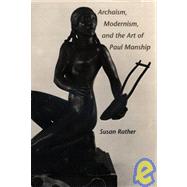
Archaism, Modernism, and the Art of Paul Manship
by Rather, Susan-

Free Shipping on All Orders!
*excludes Marketplace items.
Buy New
Rent Textbook
Rent Digital
Used Textbook
We're Sorry
Sold Out
How Marketplace Works:
- This item is offered by an independent seller and not shipped from our warehouse
- Item details like edition and cover design may differ from our description; see seller's comments before ordering.
- Sellers much confirm and ship within two business days; otherwise, the order will be cancelled and refunded.
- Marketplace purchases cannot be returned to eCampus.com. Contact the seller directly for inquiries; if no response within two days, contact customer service.
- Additional shipping costs apply to Marketplace purchases. Review shipping costs at checkout.
Summary
Rather rejects the prevailing conception of archaism as a sterile and superficial academic style to argue its initial importance as a modernist mode of expression. The early practitioners of archaism - including Aristide Maillol, Andre Derain, and Constantin Brancusi - renounced the rhetorical excess, overrefined naturalism, and indirect techniques of late nineteenth-century sculpture in favor of nonnarrative, stylized and directly carved works, for which archaic Greek art offered an important example. Their position found implicit support in the contemporaneous theoretical writings of Emmanuel Lowy, Wilhelm Worringer, and Adolf von Hildebrand.
The perceived relationship between archaic art and tradition ultimately compromised the modernist authority of archaism and made possible its absorption by academic and reactionary forces during the 1910s. By the 1920s, Paul Manship was identified with archaism, which had become an important element in the aesthetic of public sculpture of both democratic and totalitarian societies. Sculptors often employed archaizing stylizations as ends in themselves and with the intent of evoking the foundations of a classical art diminished in potency by its ubiquity and obsolescence. Such stylistic archaism was not an empty formal exercise but an urgent affirmation of traditional values under siege. Concurrently, archaism entered the mainstream of fashionable modernity as an ingredient in the popular and commercial style known as Art Deco. Both developments fueled the condemnation of archaism - and of Manship, its most visible exemplar - by the avant-garde. Rather's exploration of the critical debate over archaism, finally, illuminates the uncertain relationship to modernism on the part of many critics and highlights the problematic positions of sculpture in the modernist discourse.
The first book-length study of archaism and the first critical study of Paul Manship, this work will be important reading in several fields, including American studies and twentieth-century art history. Numerous black-and-white illustrations complement the text.
Table of Contents
| Illustrations | |
| Acknowledgments | |
| Introduction | p. 1 |
| The American Academy in Rome and the Formation of Manship's Archaism | p. 9 |
| The Archaeological Background | p. 40 |
| Archaism as Modernism: Content and Technique | p. 51 |
| Centaur and Dryad: Manship's Art in Context | p. 76 |
| Archaism from Other Places and in Other Modes | p. 107 |
| Archaism during the 1920s and 1930s: Decorative and Monumental | p. 132 |
| Archaism and the Critics: Disenchantment | p. 164 |
| Appendix: "The Decorative Value of Greek Sculpture" | p. 183 |
| Notes | p. 191 |
| Bibliography of Works Cited | p. 237 |
| Index | p. 259 |
| Table of Contents provided by Blackwell. All Rights Reserved. |
An electronic version of this book is available through VitalSource.
This book is viewable on PC, Mac, iPhone, iPad, iPod Touch, and most smartphones.
By purchasing, you will be able to view this book online, as well as download it, for the chosen number of days.
Digital License
You are licensing a digital product for a set duration. Durations are set forth in the product description, with "Lifetime" typically meaning five (5) years of online access and permanent download to a supported device. All licenses are non-transferable.
More details can be found here.
A downloadable version of this book is available through the eCampus Reader or compatible Adobe readers.
Applications are available on iOS, Android, PC, Mac, and Windows Mobile platforms.
Please view the compatibility matrix prior to purchase.
